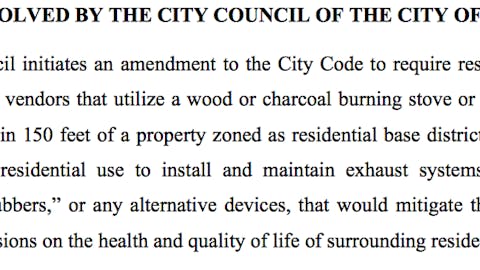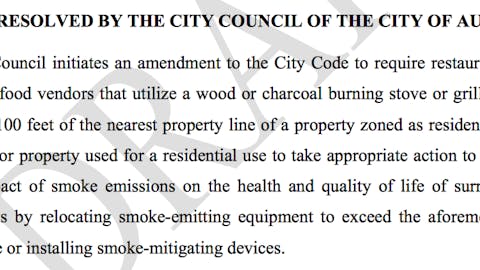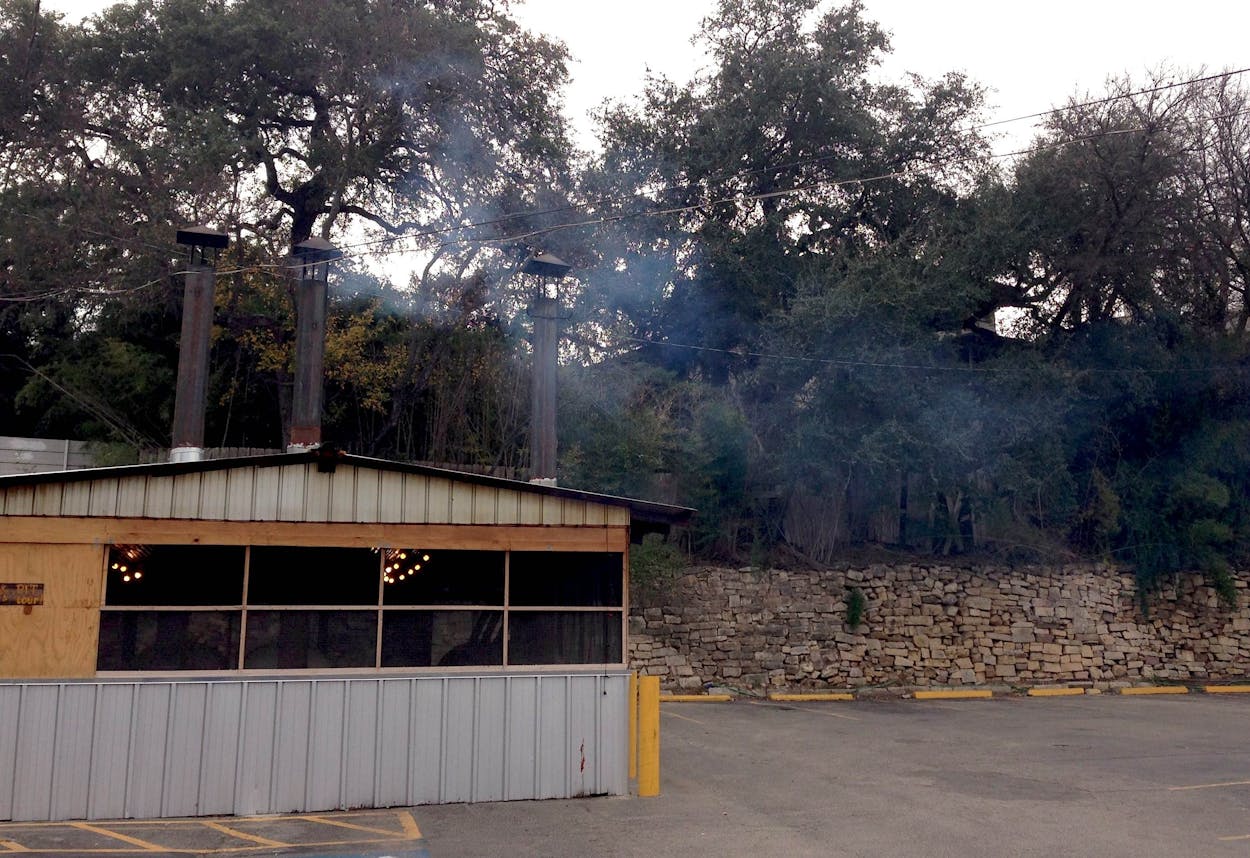If you live on the outskirts of Austin, your suburb might be the new target for barbecue joints looking to open in Travis County. That is if prospective restaurateurs see a new resolution from the Austin City Council as too onerous. It requires that barbecue smokers (and other wood-fired cooking devices) be placed at least 100 feet from adjacent residential property lines, or that they “mitigate the impact of smoke emissions” on their neighbors.
Aaron Franklin, the owner of the enormously popular Franklin Barbecue, is usually reserved in his comments when it comes to politics, but a previous version of the resolution struck a chord for the restaurateur. Early on Monday, before the resolution was revised, he minced no words when he told Eater Austin, “If this resolution passes, we would be forced to close or move. It would destroy Austin barbecue.” Then he went to work—but not at his restaurant. Franklin spent most of Monday lobbying city council members and the mayor at City Hall.
Austin has been making headlines for the past several years for its burgeoning barbecue scene. Most recently, national media couldn’t get enough of the newly minted barbecue capital during SXSW, with Bon Appétit producing a list of the best barbecue in town, and Jimmy Kimmel, who filmed his late night talk show in Austin during the festival, turning to “Franklin’s [sic] Barbecue” for his first joke of the week. Austin has become so synonymous with barbecue that when global manufacturing giant GE wanted to make an impact during SXSW, they built and experimental Super Smoker. And in a move that, ahem, could bite the hand that feeds this craze, the council will be seeking limitations on how barbecue joints prepare what is quickly becoming the city’s most famous cuisine.
If the resolution strikes you as a bit meddlesome, you wouldn’t be the only one who thinks so. Travel forty miles southwest of Austin to Lockhart, where four barbecue restaurants are clustered in the small town of just over 13,000, and you’ll find that Black’s Barbecue on Main Street is surrounded by single family homes on the same block. They’ve been smoking meats there since 1932, and manager Kent Black says he doesn’t remember any complaints about barbecue smoke. It only took Austin about six years of sustained barbecue growth for the city to turn on one of its current cash cows.
It all began with a bit of unfortunate topography. The homes along Daniel Drive in the Bouldin Creek neighborhood sit a good ten feet above the adjacent Barton Springs Road. That’s where Terry Black’s Barbecue opened last June with their wood burning smokers. The top of the smokestacks are right at the level of the back porches behind them, and given the proximity, it didn’t take long for residents to notice the new billows. By August the issue was already mentioned in meeting minutes of the neighborhood association. The neighborhood association was trying to negotiate directly with Terry Black’s Barbecue to address the smoke issue, but, according to Daniel Drive resident Guy Watts, it all became public when a reporter came knocking on his door. To be clear, Watts says neither he nor his neighborhood association initiated the pending council resolution, but more on that later.
This led to another local news spot—a January 18 story in the Austin American-Statesman (paywalled)—and by this time, it seemed the neighborhood and Terry Black’s were headed toward a mutually agreed upon resolution. But the proposed solutions still had problems. First the restaurant said it would employ a bank of fans to blow the smoke in the other direction; the neighborhood didn’t like the trade-off of air pollution to noise pollution. The neighborhood then in turn asked for “smoke scrubbers” to be installed; the hefty price tag for those scrubbers (they can top out at $70,000) seemed to be an excessively costly requirement for barbecue joints. I reached out to Michael and Mark Black for their take on the negotiations, but they didn’t feel comfortable providing any comment.
Watts may be at wit’s end, but he agrees that the Bouldin Creek situation is unique, and it doesn’t translate directly to the experience of neighborhoods near other local barbecue joints. “I think you can differentiate what Terry Black’s is doing with Franklin or La Barbecue, both in terms of residential proximity, but also in terms of the amount of wood being smoked.” Terry Black’s is open every day of the week and serves both lunch and dinner. The amount of wood they go through is simply going to be greater.
But given that the city has now intervened, this hyper-local issue could potentially affect businesses citywide. The resolution came from Eduardo “Pio” Renteria from District 3. His district doesn’t encompass Terry Black’s, so the complaints he heard were directed at a different target: La Barbecue. “My constituents on 2nd Street [behind La Barbecue] are so fed up they’re talking about selling their houses,” he told me in a phone conversation. It was those complaints that led to his first resolution draft that required “smoke scrubbers” for restaurants that use wood for cooking. After Renteria’s conversation with Aaron Franklin at City Hall, that language has been eliminated. “When we started doing more research into it we found out the scrubbers are very expensive, and sometimes they have a negative effect on the quality of how the meat gets cooked.”


To get some idea of the cost of the previously proposed smoke scrubbers, I reached out to a business with close ties to Texas in one of the few cities that require this type of pollution control: New York City. Mark Glosserman who runs Hill Country Barbecue Market in New York and DC gave me the raw numbers for their latest location in Brooklyn. “For new restaurants we budget around $60,000-$75,000 for smoke control units. We have two units…to handle our smoke capacity and for redundancy. This includes the unit itself plus installation labor.” That’s almost $38,000 per unit. Then he pays an additional $13,200 per year for maintenance. That’s right, just a single “smoke scrubber” at Hill Country costs more than most commercial smokers on the market.
Another potential solution could be a smaller Smog Hog unit. I spoke with John Milius of United Air Specialists who is a product rep for Smog Hog. He said the big roof-mounted units like what they use at Hill Country are made for large operators in a downtown area. Milius surmised that a smaller model like their new MSH-11 would be more applicable to a single-smoker food trailer and estimated that it would run closer to $4500-$5000 per unit. That’s not exactly pocket change, and could still cripple a small, independent barbecue joint. This is why Renteria is now emphasizing the new recommendation of moving the problem away from surrounding homes. As long as the smoker exhaust is 100 feet from the nearest residential property line, the restaurant would be considered in compliance with city code. That will come as a relief to any barbecue joint with the freedom to move their smoker, and will likely prompt the folks at Terry Black’s to get out their measuring tape.
For all those who see Renteria as a villain against the barbecue community, I’d say he was simply responding to the complaints of residents that he represents. The hastily drawn up resolution that resulted was troublesome, but the rework is an improvement. That doesn’t mean the new rules won’t have an affect on the continued growth of barbecue in Austin, a city that has embraced food trucks (remember that’s where Franklin Barbecue started) like none other. That acceptance has helped build a diverse food community by lowering the barriers for entry into the restaurant business. With passage of the resolution, that barrier would be raised a little higher for new restaurateurs who want to deal in smoked meat.
Just to be sure, I did have to ask Renteria if he liked barbecue. “I have nothing against barbecue. I eat it at least once a week.” He also said the comments on both sides of the issues are welcome before or during Thursday’s city council meeting. “We want as much input from the stakeholders as we can get.” At the end of our conversation I asked Renteria if he’d considered that his legacy could have been the man that killed barbecue in Austin. “Yeah” he said, followed by a reflective pause. “Yeah.”
I’m ready to hear from you! Council office phone: 512-978-2103, and email: sabino.renteria@austintexas.gov #atxcouncil
— Pio Renteria (@d3forpio) January 8, 2015
It should also be noted that while Councilman Renteria initiated the resolution, two other council members, Greg Casar and Kathie Tovo, along with Mayor Steve Adler have co-signed it. The amended resolution will be up for discussion at this Thursday’s City Council meeting.
- More About:
- Franklin Barbecue
- Aaron Franklin








